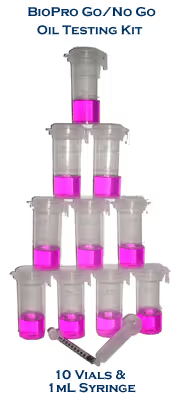Springboard Biodiesel Go/No-Go Kit

How to use the Go/No-Go Kit
By employing an acid-catalyzed esterification before the standard base-catalyzed transesterification, the BioPro processors accomplish two important things:
- the need to titrate typical used oil is eliminated
- a much wider variety of oil can be used than in most processors
Nevertheless, some oils may be encountered which may have a free fatty acid level higher than the BioPro can process. Springboard Biodiesel has developed a quick test to determine the suitability of a particular oil sample.
Included in the Go/No-Go kit:
- (10) Go/No-Go vials
- (1) one milliliter syringe
For easy use:
- Simply take a 1 ml sample of the feedstock in question.
- Add this to one of the pre-measured Go/No-Go vials.
- Shake vigorously for 10 seconds.
- If the sample stays purple, it is a Go.
Make sure that the oil is free of water and particulates, and it will process well in your machine. (This test only measures FFA levels in the feedstock. Please refer to the section in your owners manual entitled Feedstock for further information or see our website page on feedstocks.)
If the sample turns yellow, it is a No-Go, the FFA (free fatty acid) level is so high that it is not recommended for processing in the BioPro.
Theory behind the test
Each vial is set to change color if the sample of feedstock is 5% FFA or greater.
If you want to tell more precisely how acidic the sample of feedstock is, simply see how much of it is needed to turn the fluid yellow.For example, if it takes 2 ml of oil to turn the fluid in the vial yellow, then the sample of oil is only 2.5% FFA.If it only takes ½ of a milliliter of oil to turn the fluid yellow, then there is 10% FFA in the oil.Please take note of the accompanying chart in your owners manual on page 25 to see the ramifications that this has for biodiesel processing. Many customers are able to use this information to dilute high FFA oil from one source with low FFA oil from another source. This allows them to process all of the potential feedstock they are able to find.
For those with experience at waste oil titrations
Percent FFA was used in this test instead of titration number due to the fact that it is an unambiguous measurement. (Titration methods can vary.) If a user were to use the titration method described at Utah Biodiesel Supply, you could convert this to a percent FFA by first subtracting 7 from the KOH result or 5.5 from the NaOH result. Then, you would divide by 1.3 if using NaOH or 1.8 if using KOH. This will give the approximate percent FFA in the feedstock.For example, a KOH titration of 16 would equate to 5% FFA.
To go from %FFA to titration number you would use the reverse formula:
(%FFA × 1.3) + 5.5 for NaOH
and
(%FFA × 1.8) + 7.0 for KOH
Please note that on some very rare occasions, the oil is contaminated with an acid of a mineral origin such as hydrochloric acid which is used as a cleaner.In such circumstances a sample could pass the Go/No-Go test but not be able to be processed.












.svg)
